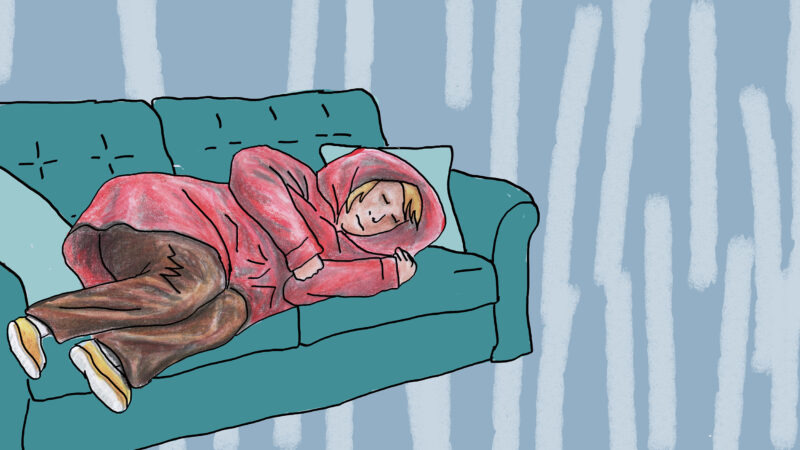Stress and coping
People with endometriosis often have stressful lives. The reason for this becomes obvious when we look at how people have evolved to cope with the demands in our environment.

Humans have evolved to detect threats in their environment
People with endometriosis face many demands in their everyday life. Anything from small disruptions to their daily life caused by the disease to more severe symptoms and pain. Even deciding the right level and type of care for symptoms could be very demanding for people, especially as the disease progresses. Any of these demands could be viewed as a serious threat to people’s wellbeing.
What demands count as a threat?
When something happens in our lives (an event or demand) we unconsciously ask ourselves: “Could this event threaten my wellbeing?”. The answer to that will depend on:
- Features of the event
Events that are negative, about to happen soon, that are unpredictable or uncontrollable all make it more likely that we will think an event is a threat. - Our personality
People that are by nature or circumstance more anxious and pessimistic are more likely to see events or demands as a threat. - Other life stressors and hassles
Having other stressors or hassles means that an event that might have been OK on its own is more likely to be seen as a threat. This unfortunately means that the more demands we have, the more likely we are to see new demands as threatening.
Many of the demands people with endometriosis face are seen as threatening to their wellbeing because these factors often apply. Unpredictable and uncontrollable negative symptoms, additional pressures on daily life caused by the disease and the mental health effects of living with a chronic health condition all contribute to seeing additional demands as threats. Every time we see a threat the coping process is triggered. When we do not perceive an event or demands as a threat then the coping process is not triggered.
Humans have also evolved to be resourceful to manage threats
When a threat is perceived in our environment we start looking for ways to manage it. We look at what tools we have available – these are called resources.

What counts as a resource?
When we see a threat in our environment we ask ourselves: “Do I have the coping resources to cope with this threat?” People could have access to different resources. The answer to this question will then depend on :
- ‘Actual’ resources
Having resources like money, knowledge or good health makes it easier to cope with threats. - Our personality
Being more optimistic and resilient makes it easier to cope with threats - Our coping style
Knowing or having learned different strategies to cope with threats in the past and having developed preferred ways to cope will help people feel they have resources to manage the threats in their lives. The kind of strategy that could help manage a threat depends on the situation. However, avoiding threats makes it difficult to overcome them or the anxiety they might cause because the threat is never confronted. For this reason avoidance is rarely a useful strategy. - Social support
Having people that we trust, who show us love, understanding, and can give us helpful advice and practical support also makes it easier for us to feel we have the resources to cope with a situation. Empathy from others is especially helpful. You can read more about building empathy here.
Balancing threats and resources
When we identify an event as a threat our nature is to kick-start the coping process. If we find that we have enough coping resources to cope with the threat caused by the demands in our environment we will avoid stress reactions.
What if you don’t have all the resources you need?

When there is imbalance between the size or nature of the threat and the coping resources available then we will experience stress reactions.
People with endometriosis are often missing at least some of the resources they need to manage all of the threats caused by the disease or living with the disease. These gaps in resources could be due to:
- Gaps in knowledge about endometriosis
There are many misconceptions about endometriosis as well as contradictory and misguided advice. There is poor knowledge of endometriosis disease among the general public as well as some healthcare professionals. - Lack of support from friends and family
People with endometriosis often stop telling other people about their disease and start avoiding social situations or other people because it becomes just too difficult to try to explain their invisible illness to others. - Work, stress, financial worries
People with endometriosis can experience disruptions to their schooling and working life due to their symptoms. This can end up affecting the range of resources available to them because, when symptoms are too severe to stay in work, they can experience financial worries. These add to the demands caused by endometriosis.
Stress reactions
There are too many possible stress reactions to list but here are a few:
- Feeling worried, nervous, fearful or sad, discouraged and disappointed
- Physical symptoms like panicked breathing, chest pain, nausea, and stomach cramps
- Problems with concentration, attention or sleeping
- Engaging in unhealthy behaviours like comfort eating.
Boosting coping resources
There are many ways of boosting coping resources to reduce the experience of stress reactions. These are just some of the ones people with endometriosis commonly report using:
Strategies to directly manage the demands people encounter
- Arranging school, work or social activities to avoid peak symptoms
- Managing pain using analgesics, relaxation or diet control
- Seeking social support from family and friends
- Conducting research on the internet to better understand endometriosis and find helpful explanations.
Strategies to manage the emotions caused by the demands people encounter
- Reframing thoughts about the disease to accept and learn to live with it
- Self-talk for encouraging and reassuring self
- Trying to see positives
- Spirituality
- Nutritional management
- Rest
- Exercise.
Strategies to find other people experiencing endometriosis
A useful way to manage the demands caused by endometriosis is to meet other people affected by the same condition. People can learn about the disease and share with others in a way that can help them manage the way they see the threats caused by their disease and also their ability to cope and the resources they have to cope with it.

